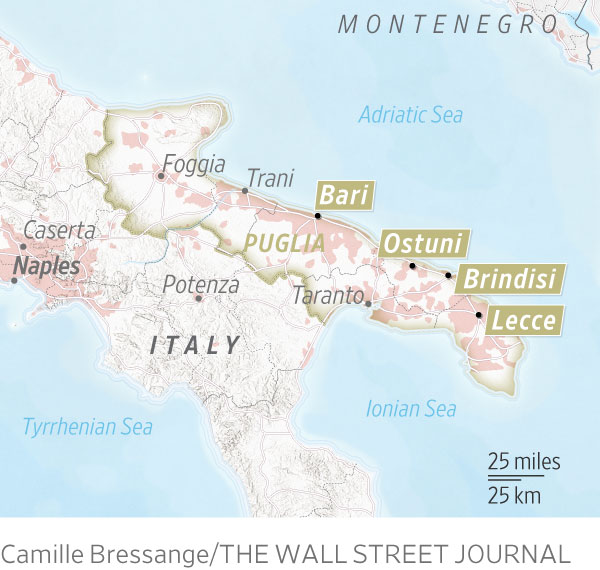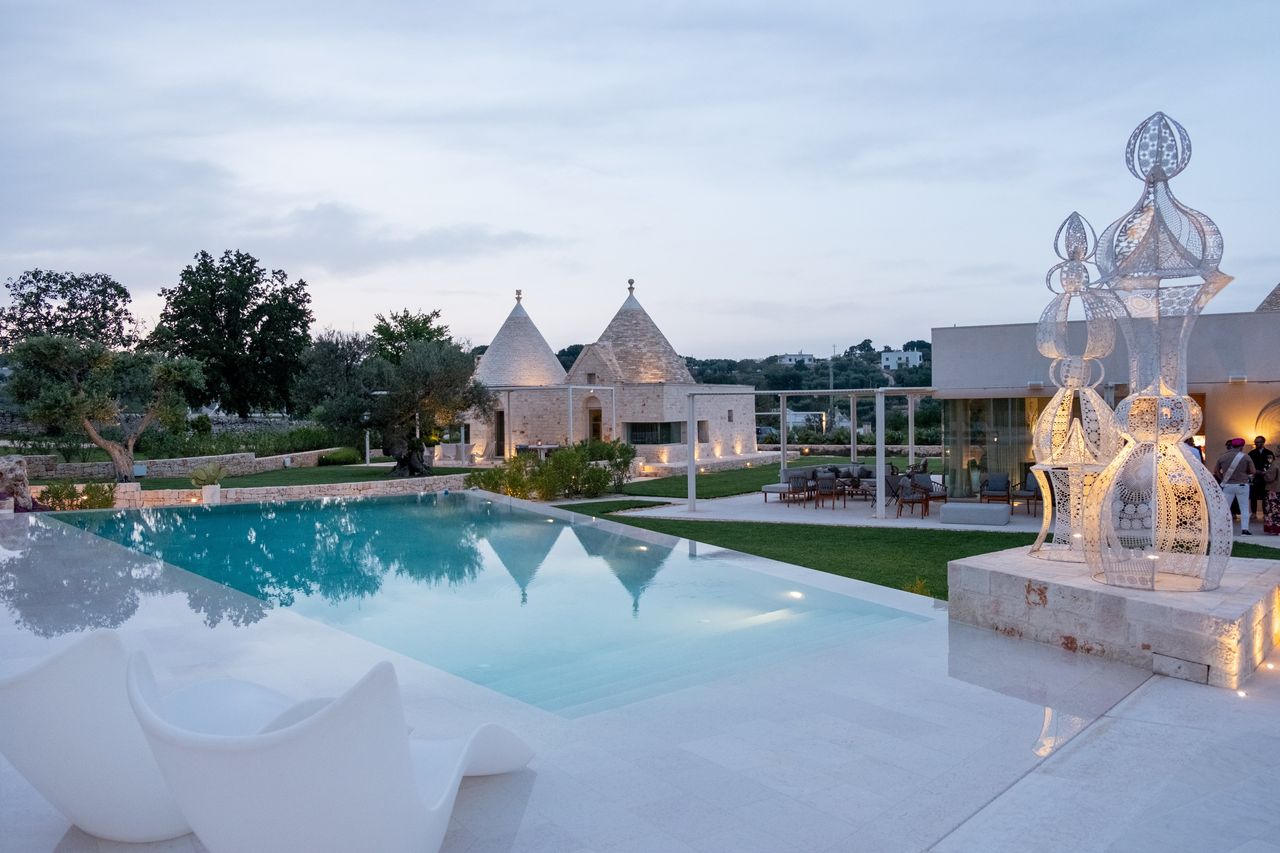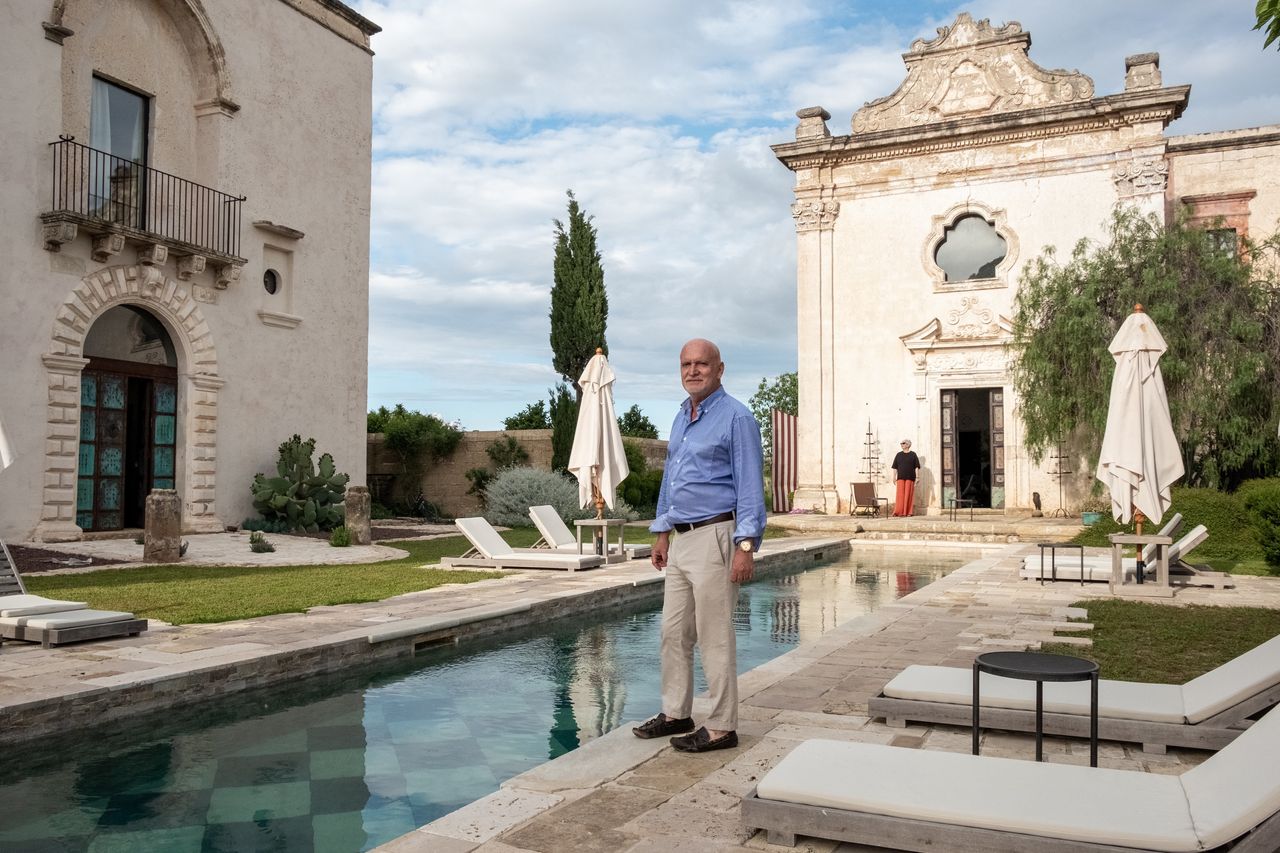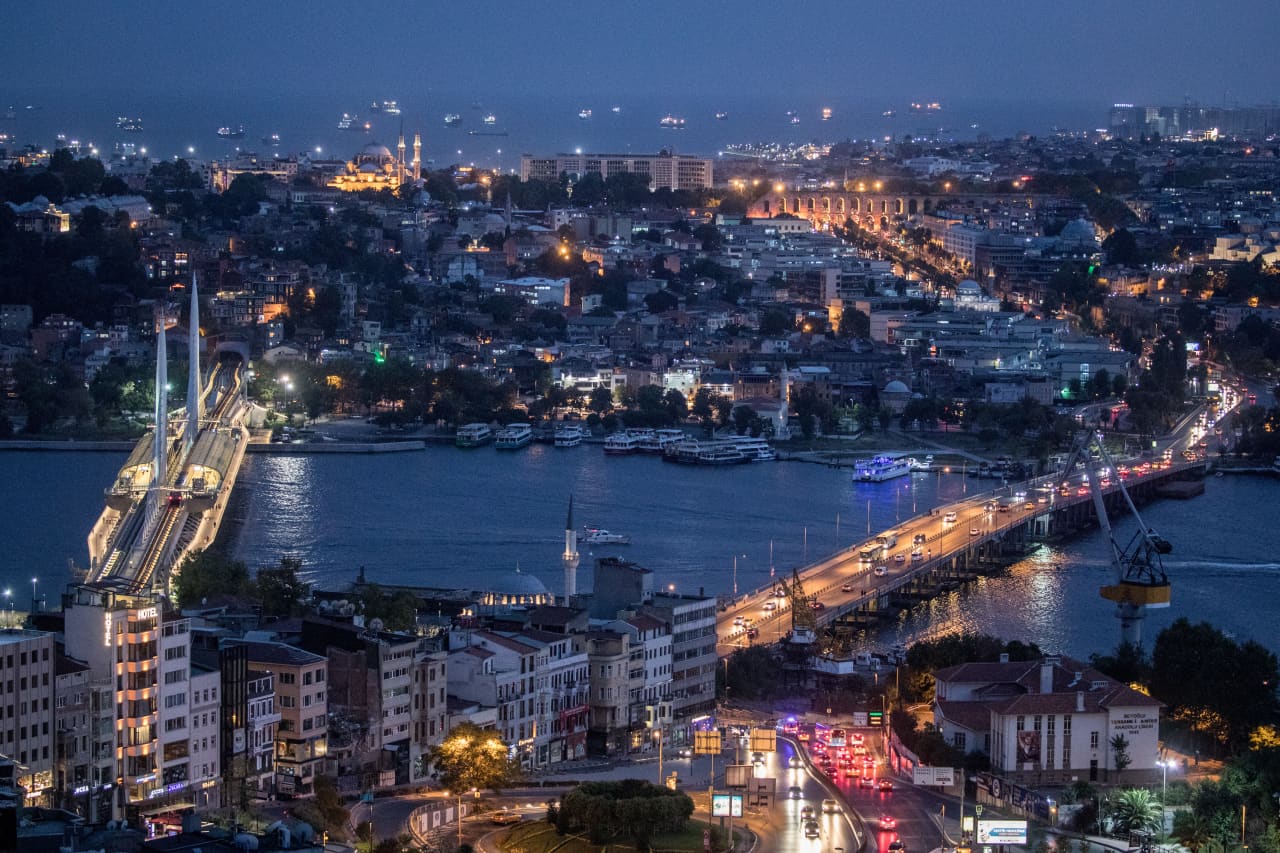Wealthy Buyers Are Turning This Region Into One of Italy’s Hottest Home Markets
Once an impoverished area, Puglia has seen an influx of high-end buyers willing to spend millions on historic farmhouses and villas
In a shaded spot near his new swimming pool, Northern Italian architect Paolo Genta is taking stock of his Southern Italian dream project—a luxurious vacation compound, serving three generations of his extended Turin family, that he created in Puglia, the region running down the heel of Italy’s boot.
On a hot spring day, over a glass of local rosé wine and tomato-and-pasta canapés, Genta, 64, remembers his initial encounter over a decade ago with the sunbaked property, which he bought in stages between 2012 and 2015, for $537,400, and then restored up through 2022.

“A friend took me here,” he says, of the 2/3-acre estate, then in ruins. “But it immediately felt familiar to me—as if I already knew it.”
He has gone on to spend around $1.075 million to realise his vision by renovating three adjacent structures, dating back to at least the 18 century, as well as $236,400 on the lavish landscaping. He and the Genta clan plan to use the compound’s seven bedrooms, spread over two buildings, up to a few months a year. The third building, a deconsecrated Baroque chapel, is the perfect place to have a cool lunch on a hot day.
Genta is one of a growing number of luxury-minded homeowners who are transforming Puglia, once a remote and impoverished corner of Italy, into an outpost of upscale living. Historical stone farmhouses, called masserie, are getting high-tech upgrades, while Puglia’s traditional cone-topped rural structures, called trulli, are being converted into high-end primary suites.
Puglia is one of the few areas of mainland Southern Italy—along with the Campania region, home to Naples and the Amalfi Coast—to develop a reliable luxury real-estate sector. According to Idealista.it, the Italian residential real-estate site, home prices here now average about $121 per square foot, which is higher than in nearby Basilicata, Calabria and Abruzzo.
Luxury properties are clustered in two areas. One, Valle d’Itria, is an agricultural valley between Bari, Puglia’s largest city, and Ostuni, an old, atmospheric hilltop town. This is ground zero for Puglia’s trulli legacy. Thousands of the structures, large and small, mark the hilly countryside, creating a distinctive, rustic skyline. Further south, around the Baroque city of Lecce, lies Salento, where Genta has his compound. Flatter and hotter, with simultaneous access to both Adriatic and Ionian beaches, Salento offers more seclusion.

According to Idealista, Puglia’s Brindisi province, which includes much of Valle d’Itria, is seeing the region’s strongest price increases, up 9.2% between May 2022 and May 2023. The most expensive sale in 2022 was a 6,500-square-foot Salento masseria, not far from the Genta compound, which sold for $3.78 million.
Valle d’Itria is known for its white-stone towns and exclusive hotels, such as Borgo Egnazia, a 40-acre coastal resort, where high-season prices can reach $26,585 a night. Near Ostuni, a restored, trulli-topped stone house dating back several centuries has an asking price of $1.72 million; the five-bedroom home sits on a roughly 7.5-acre lot.
Valle d’Itria appeals to design royalty, such as Milan’s MariaCristina Buccellati, who works with her family’s luxury jewellery label, now owned by Richemont. Salento, meanwhile, attracts Hollywood royalty; local homeowners include actress Helen Mirren and her husband, director Taylor Hackford. In Salento, near the very bottom of the heel, a restored 12-bedroom castle, with a large enclosed garden, has an asking price of $3.56 million.
Canadian couple Alper Ozdemir and Cynthia Liu, who arrived in Puglia from Toronto in late 2021, have bought in the heart of Valle d’Itria. The active retirees, both in their early 50s, left behind Ontario’s cold climate for Puglia’s good food, warm weather and close-to-nature lifestyle, says Ozdemir.
In February 2022, they closed on a 7.5-acre farm with a trulli-topped ruin. They paid $247,000 for the property, and plan to spend about $860,000 to turn the 3,850-square-foot structure into a two-story, three-bedroom home, built around a new swimming pool.
Like many luxury buyers in the area, the couple narrowed their choice between Valle d’Itria and Salento, settling on the former. “Salento is nice in the summer,” says Ozdemir, “but people live around here year round.”
Puglia overall has become increasingly accessible. It is now part of Italy’s high-speed train network, and it has two international airports. Staying in a local rental to oversee their renovation, Ozdemir and Liu plan to use their new home, set to be completed in 2024, as a base for exploring the country.
A new set of buyers from the San Francisco Bay Area, brothers Mark and Peter Alwast, also regard their 2-acre Valle d’Itria homestead, purchased for $355,000 in September 2022, as a convenient toehold, with plans to explore Europe. The brothers, along with Peter Alwast’s life partner and Mark Alwast’s husband, expect to spend about $322,000 to renovate a 3,000-square-foot house for their retirement.
Meanwhile, they will use it as a vacation home. Despite the far longer travel time, the foursome view it as an alternative to Northern California wine country. “In Puglia you get a lot more for your money,” says Mark Alwast, 60, a designer.
Patience is often required from buyers in Puglia. Genta needed to piece together his compound from eight different owners, with some holding out for years. Retired New York attorney Ellen Bonaventura, 62, has spent the past nine years putting back together a Salento palazzo, a 30-minute drive south of Lecce, from a cluster of disparate buildings. “It was always my dream to have a house in Italy,” says the full-time Puglia resident, who estimates that she has spent $495,000 on real estate, about $3.22 million on renovation costs and around $537,000 on furniture and art, including Neapolitan and Sicilian antiques.
To-do lists tend to grow for this new round of Puglia homeowners. In 2021, Paolo Colombo, an architect based in Lugano, Switzerland, paid $1.94 million to buy two multi trulli structures on a 3.7-acre hilltop Valle d’Itria property, and then spent $2.16 million to renovate the two buildings—which required disassembling, cleaning and reassembling the massive stonework. Completed this June, the renovation will be followed soon, says Colombo, by a free-standing, latticework yoga studio and new outdoor sleeping areas, which will give his family of five a total of eight bedrooms in the main house.

Rula Al Amad and James Woods, a Milan-based, Palestinian-American couple, have expanded their Puglia portfolio. Valle d’Itria pioneers, they started in 2006, when they paid a mere $129,000 to buy a derelict set of trulli, then spent $295,000 over the following several years to create a 2,000-square-foot vacation home.
Sensing it had become too small for their family of four, the couple paid $537,000 in 2018 for a nearby derelict masseria. They then spent about $1.57 million on a gut renovation, which wrapped up this spring. The finished compound can comfortably sleep up to 10.
Speaking in her new living room, which emphasizes the 500-year-old masseria’s use of historic local limestone, Al Amad, who first stayed in the house this past Easter, is looking ahead to winter. “We go to Michigan at Christmas but come back to Italy for New Year’s,” she says of the routine of her Midwest-born husband and their two teenage boys. “I can see doing a big New Year’s Eve party here.”
 Copyright 2020, Dow Jones & Company, Inc. All Rights Reserved Worldwide. LEARN MORE
Copyright 2020, Dow Jones & Company, Inc. All Rights Reserved Worldwide. LEARN MORE
This stylish family home combines a classic palette and finishes with a flexible floorplan
Just 55 minutes from Sydney, make this your creative getaway located in the majestic Hawkesbury region.
As Paris makes its final preparations for the Olympic games, its residents are busy with their own—packing their suitcases, confirming their reservations, and getting out of town.
Worried about the hordes of crowds and overall chaos the Olympics could bring, Parisians are fleeing the city in droves and inundating resort cities around the country. Hotels and holiday rentals in some of France’s most popular vacation destinations—from the French Riviera in the south to the beaches of Normandy in the north—say they are expecting massive crowds this year in advance of the Olympics. The games will run from July 26-Aug. 1.
“It’s already a major holiday season for us, and beyond that, we have the Olympics,” says Stéphane Personeni, general manager of the Lily of the Valley hotel in Saint Tropez. “People began booking early this year.”
Personeni’s hotel typically has no issues filling its rooms each summer—by May of each year, the luxury hotel typically finds itself completely booked out for the months of July and August. But this year, the 53-room hotel began filling up for summer reservations in February.
“We told our regular guests that everything—hotels, apartments, villas—are going to be hard to find this summer,” Personeni says. His neighbours around Saint Tropez say they’re similarly booked up.
As of March, the online marketplace Gens de Confiance (“Trusted People”), saw a 50% increase in reservations from Parisians seeking vacation rentals outside the capital during the Olympics.
Already, August is a popular vacation time for the French. With a minimum of five weeks of vacation mandated by law, many decide to take the entire month off, renting out villas in beachside destinations for longer periods.
But beyond the typical August travel, the Olympics are having a real impact, says Bertille Marchal, a spokesperson for Gens de Confiance.
“We’ve seen nearly three times more reservations for the dates of the Olympics than the following two weeks,” Marchal says. “The increase is definitely linked to the Olympic Games.”

Getty Images
According to the site, the most sought-out vacation destinations are Morbihan and Loire-Atlantique, a seaside region in the northwest; le Var, a coastal area within the southeast of France along the Côte d’Azur; and the island of Corsica in the Mediterranean.
Meanwhile, the Olympics haven’t necessarily been a boon to foreign tourism in the country. Many tourists who might have otherwise come to France are avoiding it this year in favour of other European capitals. In Paris, demand for stays at high-end hotels has collapsed, with bookings down 50% in July compared to last year, according to UMIH Prestige, which represents hotels charging at least €800 ($865) a night for rooms.
Earlier this year, high-end restaurants and concierges said the Olympics might even be an opportunity to score a hard-get-seat at the city’s fine dining.
In the Occitanie region in southwest France, the overall number of reservations this summer hasn’t changed much from last year, says Vincent Gare, president of the regional tourism committee there.
“But looking further at the numbers, we do see an increase in the clientele coming from the Paris region,” Gare told Le Figaro, noting that the increase in reservations has fallen directly on the dates of the Olympic games.
Michel Barré, a retiree living in Paris’s Le Marais neighbourhood, is one of those opting for the beach rather than the opening ceremony. In January, he booked a stay in Normandy for two weeks.
“Even though it’s a major European capital, Paris is still a small city—it’s a massive effort to host all of these events,” Barré says. “The Olympics are going to be a mess.”
More than anything, he just wants some calm after an event-filled summer in Paris, which just before the Olympics experienced the drama of a snap election called by Macron.
“It’s been a hectic summer here,” he says.

AFP via Getty Images
Parisians—Barré included—feel that the city, by over-catering to its tourists, is driving out many residents.
Parts of the Seine—usually one of the most popular summertime hangout spots —have been closed off for weeks as the city installs bleachers and Olympics signage. In certain neighbourhoods, residents will need to scan a QR code with police to access their own apartments. And from the Olympics to Sept. 8, Paris is nearly doubling the price of transit tickets from €2.15 to €4 per ride.
The city’s clear willingness to capitalise on its tourists has motivated some residents to do the same. In March, the number of active Airbnb listings in Paris reached an all-time high as hosts rushed to list their apartments. Listings grew 40% from the same time last year, according to the company.
With their regular clients taking off, Parisian restaurants and merchants are complaining that business is down.
“Are there any Parisians left in Paris?” Alaine Fontaine, president of the restaurant industry association, told the radio station Franceinfo on Sunday. “For the last three weeks, there haven’t been any here.”
Still, for all the talk of those leaving, there are plenty who have decided to stick around.
Jay Swanson, an American expat and YouTuber, can’t imagine leaving during the Olympics—he secured his tickets to see ping pong and volleyball last year. He’s also less concerned about the crowds and road closures than others, having just put together a series of videos explaining how to navigate Paris during the games.
“It’s been 100 years since the Games came to Paris; when else will we get a chance to host the world like this?” Swanson says. “So many Parisians are leaving and tourism is down, so not only will it be quiet but the only people left will be here for a party.”
This stylish family home combines a classic palette and finishes with a flexible floorplan
Just 55 minutes from Sydney, make this your creative getaway located in the majestic Hawkesbury region.






















